I was visiting Barcelona, I was visiting the first Gaudi house, I was looking at a flea market searching for the Holy Grail,
I was walking in the drizzle, I was looking for joy, happiness and the sky. Someone said: take what you want, say the Good God, but be prepared to pay for it. Dreams cost money, sweet, frustration, tears, courage, choices and extraordinary penitence.
However, birthing a dream requires more one thing, love.
In 1883, Manel Vicens I Montaner commissioned his dream summer house “Casa Vicens” with his art love for his beloved wife where they could escape the suffocating heat of summer in the Barcelona. He was a resident of Barcelona, a stockbroker and currency dealer and art lover. He built his house between 1883 and 1885, in Barcelona’s Gràcia district, which was then that time a village with his dream. On 30 January 1883, Manuel Vicens i Montaner applied for a permit from Vila de Gràcia Town Council to demolish the house inherited from his mother. A few days after receiving approval from the Town Council, on 20 February 1883, Mr Vicens filed a new application as expected, he requested a permit to build a new house according to the project signed by the young architect Antoni Gaudí.
He was a resident of Barcelona, a stockbroker and currency dealer and art lover. He built his house between 1883 and 1885, in Barcelona’s Gràcia district, which was then that time a village with his dream. On 30 January 1883, Manuel Vicens i Montaner applied for a permit from Vila de Gràcia Town Council to demolish the house inherited from his mother. A few days after receiving approval from the Town Council, on 20 February 1883, Mr Vicens filed a new application as expected, he requested a permit to build a new house according to the project signed by the young architect Antoni Gaudí.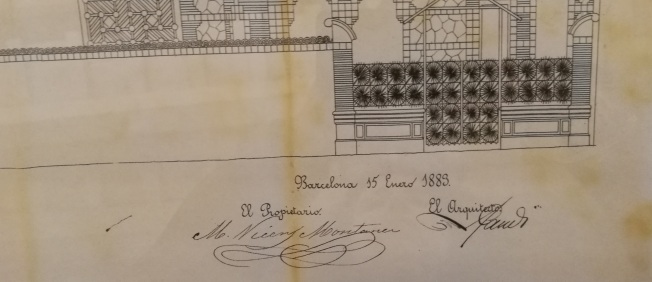 The set of plans was attached to the application and sent to the Town Council. But Casa Vicens the project does not start until 1883. It is, therefore, possible that several years passed after Mr Vicens commissioned the work from Gaudí before the procedures to carry it out began. This house designed by Antoni Gaudí is known as a first Gaudi house and it is known as better for his unfinished masterpiece, La Sagrada Familia. During my visit, I was asking myself what makes a house a home? It seems like a simple question, but the answer is a little more complex. In many ways, homes symbolise how we live and see ourselves. Moreover, these spaces evolve when we focus on what makes us happy. This is sometimes easier said than done, though. It requires reflection and thoughtful choices, but it is a rewarding process. When we create a place that meets our needs and expresses our character, we enrich our lives. When we walk into some homes, they instantly feel welcome. In addition, it is not just, it’s not just because you enjoy the company or admire the decor – although both help. There is something else. Space feels authentic, a genuine reflection of the person or people who live there. Before we pick up a hammer, a paintbrush, we need to daydream. We need to walk through the different rooms where we eat, sleep and live. We need to realize that the home of our dreams dwells within. We must find it in the secrets sanctuary of your heart today before you can cross the threshold of tomorrow.
The set of plans was attached to the application and sent to the Town Council. But Casa Vicens the project does not start until 1883. It is, therefore, possible that several years passed after Mr Vicens commissioned the work from Gaudí before the procedures to carry it out began. This house designed by Antoni Gaudí is known as a first Gaudi house and it is known as better for his unfinished masterpiece, La Sagrada Familia. During my visit, I was asking myself what makes a house a home? It seems like a simple question, but the answer is a little more complex. In many ways, homes symbolise how we live and see ourselves. Moreover, these spaces evolve when we focus on what makes us happy. This is sometimes easier said than done, though. It requires reflection and thoughtful choices, but it is a rewarding process. When we create a place that meets our needs and expresses our character, we enrich our lives. When we walk into some homes, they instantly feel welcome. In addition, it is not just, it’s not just because you enjoy the company or admire the decor – although both help. There is something else. Space feels authentic, a genuine reflection of the person or people who live there. Before we pick up a hammer, a paintbrush, we need to daydream. We need to walk through the different rooms where we eat, sleep and live. We need to realize that the home of our dreams dwells within. We must find it in the secrets sanctuary of your heart today before you can cross the threshold of tomorrow.
How 33-year-old Gaudí after graduating from the Regional School of Architecture made this house space into a summer homely space? What the Gaudi looked for? What the Manel Vicens I Montaner looked for? What we are looking for? How Vicens contacted Gaudi? As of yet, I can not find the definite answer to these questions since nobody has yet found any documentary source showing a direct link between Gaudí and his client, such as a conserved record of correspondence between both men, for example. One hypothesis is that Vicens and Gaudí frequented certain associations and organisations in Barcelona in the final quarter of the 19th century and met in that environment. This was the time of La Renaixensa, the Centre Català, the Ateneu Barcelonès and the Associació Catalanista d’Excursions Científiques, where major businessmen like Eusebi Güell gathered with writers, architects and artists such as Francesc Torrescassana and Heribert Mariezcurrezna, all later connected to Gaudí’s work and to the history of Casa Vicens. The second one that that Manuel Vicens, was an uncle of one of the great Catalan sculptors, Ismael Smith Marí, born in 1886 and he knows architects and just connected to young Gaudí. 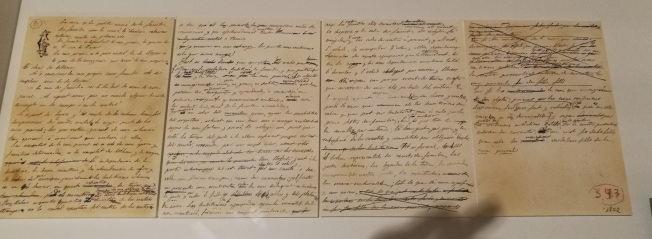 Followed one of Gaudí’s few surviving writings, we know a testimony of his thoughts on the house and the family. The title of the text is La Casa pairal (The Manor House) and is found in the notebook called Manuscript de Reus (The Manuscript of Reus), where the architect wrote down accounts and different thoughts about architecture and ornamentation. Throughout his writings, we can clearly make out Gaudí’s idea of the house in a specific socio-cultural context, although he specifies that ‘the manor house is not only needed by a certain era or family, it is needed by everyone always’. Thus, the young architect reflects on the dimensions of the site, the way the rooms of the homes are used and other subjects.
Followed one of Gaudí’s few surviving writings, we know a testimony of his thoughts on the house and the family. The title of the text is La Casa pairal (The Manor House) and is found in the notebook called Manuscript de Reus (The Manuscript of Reus), where the architect wrote down accounts and different thoughts about architecture and ornamentation. Throughout his writings, we can clearly make out Gaudí’s idea of the house in a specific socio-cultural context, although he specifies that ‘the manor house is not only needed by a certain era or family, it is needed by everyone always’. Thus, the young architect reflects on the dimensions of the site, the way the rooms of the homes are used and other subjects. 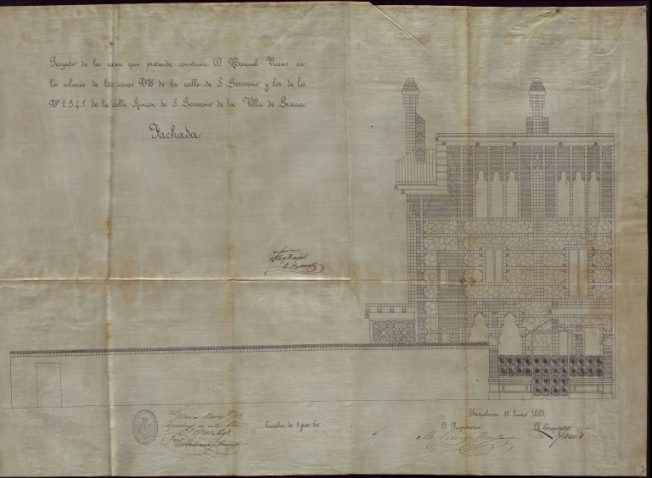 This article also sketches out the features of the ideal house, which finally take shape in Casa Vicens. He defends the concept of the manor house, an isolated home and the space of the family, which provides much better conditions than urban dwellings.
This article also sketches out the features of the ideal house, which finally take shape in Casa Vicens. He defends the concept of the manor house, an isolated home and the space of the family, which provides much better conditions than urban dwellings.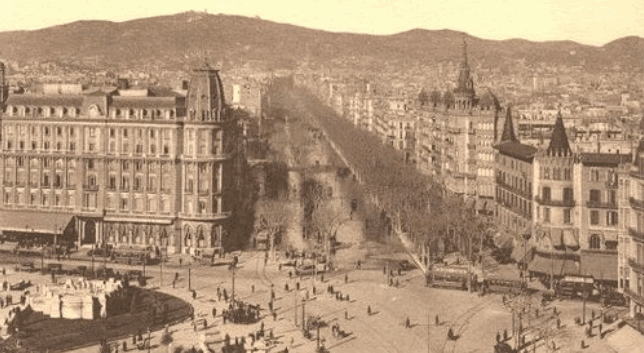
In that time, probably the main point of reference to Barcelona, a city that at that time still had more people living in the unhealthy spaces within its old walls than in the new example, whose construction was then in full swing.
In brief, the house has two objectives: first are its hygienic conditions, which make those who grow and develop in it into strong and robust beings; and second are its artistic conditions, with the constructive simplicity inherent to the techniques rooted in the Catalan tradition. Nevertheless, nature was always Gaudi’s chief inspiration, particularly Mediterranean flora and fauna. We find ivy leaves represented in the sgraffito. The dining room ceiling is full of olive leaves made with paper-mâché from the factory of Hermenegildo Miralles. On the covered porch I find sgraffito representing pomegranates and hydrangeas and a tempera painting showing palm leaves. Bramble, fern leaves, reeds and passionflower decoration of these rooms are complemented by the ceramic coffers of the beam fillings. I find yellow sunflowers and the passionflowers or passifloras. He uses all these natural elements as an architectural language at Casa Vicens and maybe beyond this possible is some iconographic interpretation linked to the cycle of the passion of Christ.
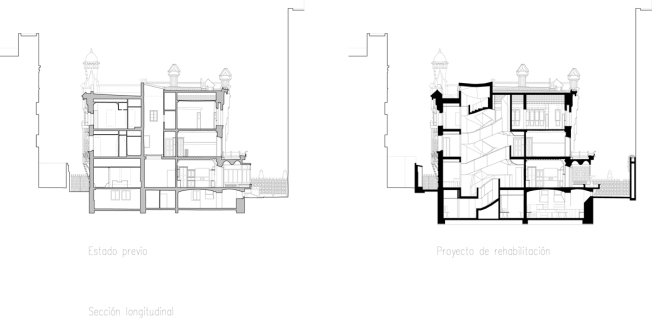 Gaudi designed a summer house divided into four levels: the basement for storage; the ground floor to house the living room, dining room and kitchen; the first floor, which was meant for the bedrooms; and the top floor for the servants. At first, the house only had three facades since it was attached to the neighbouring construction on the northeast side; the Southwest served as the main facade open to the extensive gardens surrounding the house.
Gaudi designed a summer house divided into four levels: the basement for storage; the ground floor to house the living room, dining room and kitchen; the first floor, which was meant for the bedrooms; and the top floor for the servants. At first, the house only had three facades since it was attached to the neighbouring construction on the northeast side; the Southwest served as the main facade open to the extensive gardens surrounding the house. 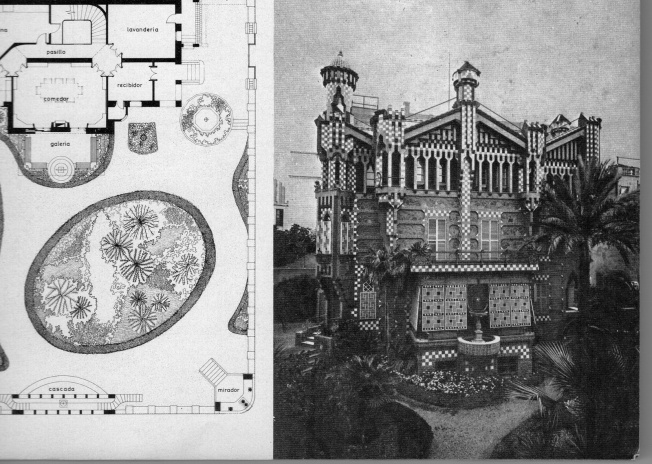 This orientation guaranteed sunlight and favourable climatic conditions during the different seasons of the year. After passing through the ground floor welcome area, you can see one of the most important spaces in the construction- the ground-floor gallery. It was planned as a semi-open space (with central dining room, smoking room and porch with a marble fountain) to connect the indoors with the outdoors, and it allowed the nature in the garden to visually enter the living room.
This orientation guaranteed sunlight and favourable climatic conditions during the different seasons of the year. After passing through the ground floor welcome area, you can see one of the most important spaces in the construction- the ground-floor gallery. It was planned as a semi-open space (with central dining room, smoking room and porch with a marble fountain) to connect the indoors with the outdoors, and it allowed the nature in the garden to visually enter the living room.
Also, the garden featured a large waterfall nestled within a parabolic arch which helped to cool off the house’s gallery. On the first floor houses are the bedrooms, full of exuberant leafy decor, and a covered porch from which to contemplate the garden. Follow museum information, apart from the fountain on the terrace, another element directly related to the water was the exposed brick waterfall, formed by a catenary arch that was located in the garden. Above the arch, there were two rows of thin brick pillars crowned by a capital with two water tanks at the ends that enabled the water to fall continuously like a fine rain into a broad basin in the archway. The spandrels of the arch were adorned with a series of terracotta bas-reliefs by the sculptor Antoni Riba.
At first, the waterfall was part of the garden fence. In addition to bringing a cool environment, it helped to protect the neighbouring building, thereby providing more privacy. The project to build the waterfall was submitted to Vila de Gràcia Town Council to obtain the building permit on 1 September 1883, when work on Casa Vicens had already begun. 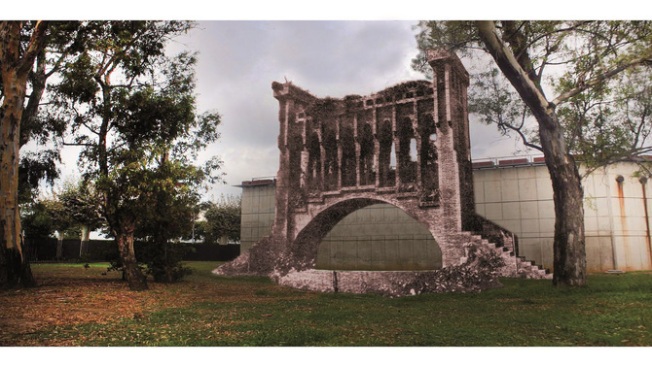 During the expansion of Casa Vicens and the garden in 1925, this waterfall was transformed into a free-standing structure, like a triumphal arch, and as usually happens it was demolished in 1946 when part of the property was sold.
During the expansion of Casa Vicens and the garden in 1925, this waterfall was transformed into a free-standing structure, like a triumphal arch, and as usually happens it was demolished in 1946 when part of the property was sold.
In the autumn of 26 October 1898, Casa Vicens was the scene of an unfortunate incident that was documented by newspapers such as La Publicidad, La Vanguardia, La Campana de Gràcia and others. The incident was the death of Ramona Domènech i Tarragó, just a 22 months old, who accidentally drowned in the garden waterfall, which has since been removed. 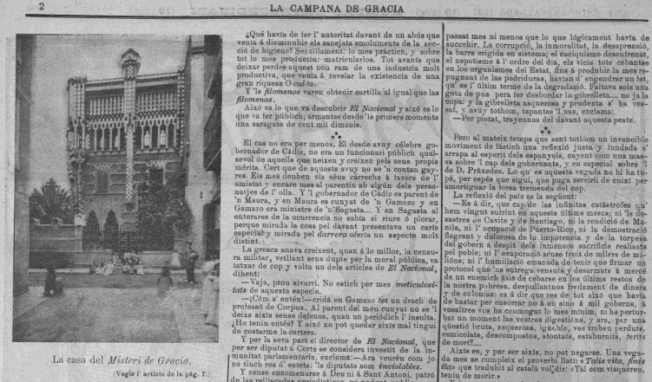 La Publicidad describes the property owned by Dolores Giralt, the widow of Manuel Vicens i Montaner and article mentions also the original style of the building, “a mixture of all the architectures that distinguishes it from the other buildings”, and describes it as a house “almost surrounded by gardens, deserted for several years”. As the newspaper explains, Mrs Giralt, Manuel Vicens’ widow, stopped living in the house after he died and went to live in the house of the rector of the church of Sant Joan de Gràcia, Francisco Llanas Viñas.
La Publicidad describes the property owned by Dolores Giralt, the widow of Manuel Vicens i Montaner and article mentions also the original style of the building, “a mixture of all the architectures that distinguishes it from the other buildings”, and describes it as a house “almost surrounded by gardens, deserted for several years”. As the newspaper explains, Mrs Giralt, Manuel Vicens’ widow, stopped living in the house after he died and went to live in the house of the rector of the church of Sant Joan de Gràcia, Francisco Llanas Viñas.

As such, it seems that Casa Vicens was a recurring topic of conversation among the residents of Gràcia in the autumn of 1898. Despite the unfortunate incident, the public opinion of the building is evident from the newspaper articles. According to one interesting passage, “as seen from Carrer de Sant Gervasi, the house has a sad appearance but seen from the gardens, it offers a gorgeous silhouette, including its daring towers, its original arches, its galleries, its beautiful parterres, etc.”
In 1925, when Manel Vicens’s widow sold the property to Doctor Antonio Jover i Puig, who converted the summer house into a permanent multi-family residence. Although the Jover family spent the next few years enlarging the house and property, the estate was divided in half in 1946. Unfortunately, at the time, Gaudí was too busy building the Sagrada Família to take part in the project, so his friend Joan Baptista Serra de Martínez designed the project with Gaudí’s approval.
Joan Baptista Serra de Martínez turned the single-family home into a three-family residence, removing Gaudí’s original staircase to construct a new staircase that would reach all three floors of the residence. He also increased the size of the gardens. Following this transaction, the freestanding arch containing the mechanics of a curtain waterfall situated at the centre of the patio was dismantled and the house was cut off from the chapel and mineral spring devoted to St. Rita so long associated with the property.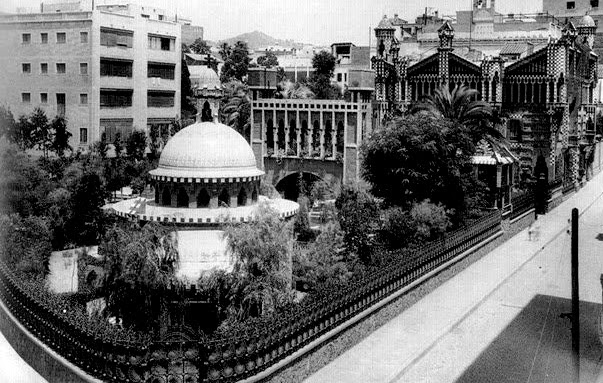
In 2005 Casa Vicens received UNESCO World Heritage Site status and two years later, the Herrero-Jover family decided to sell the property. The asking price of €35 million ($39,242,000) was dropped after months had passed and no buyer was found until the Andorran bank MoraBanc bought the property in 2014 for an undisclosed sum, the Art Newspaper reports. MoraBanc purchased the historic building in 2014 with the intention (for which I thank you:) ) now a house museum is opening to the public 🙂
Maybe someone will ask what happened with Antoni Gaudí, it was the afternoon of the 7th of June 1926, Gaudi was walking along Barcelona’s Gran Via de les Corts Catalanes on his way from the Sagrada Familia to the church of Sant Felip Neri where he often stopped by in the evening to make a confession. As he attempted to cross the wide boulevard between called Girona and called Bailén he was struck by a streetcar. Taken for a beggar due to his humble and somewhat shabby appearance, Gaudí lay unconscious in the midst of the busy thoroughfare until a policeman hailed a taxi and instructed the driver to transport him to the Hospital de la Santa Creu. As the architect had not been carrying any identification documents, no one there one realized who he was. When Gil Parés, the chaplain of the Sagrada Familia, recognized him the following morning ……… ……….but that is another story and shall be told another time.
In life, a person will come and go from many homes.
We may leave a house, a town, a room,
but that does not mean those places leave us.
Once entered,
we never entirely depart the homes we make for ourselves
in the world.
They follow us,
like shadows,
until we come upon them again,
waiting for us in the mist.

I was visiting, I was waking,
I was looking for my daughter joy, happiness and the sky.




































